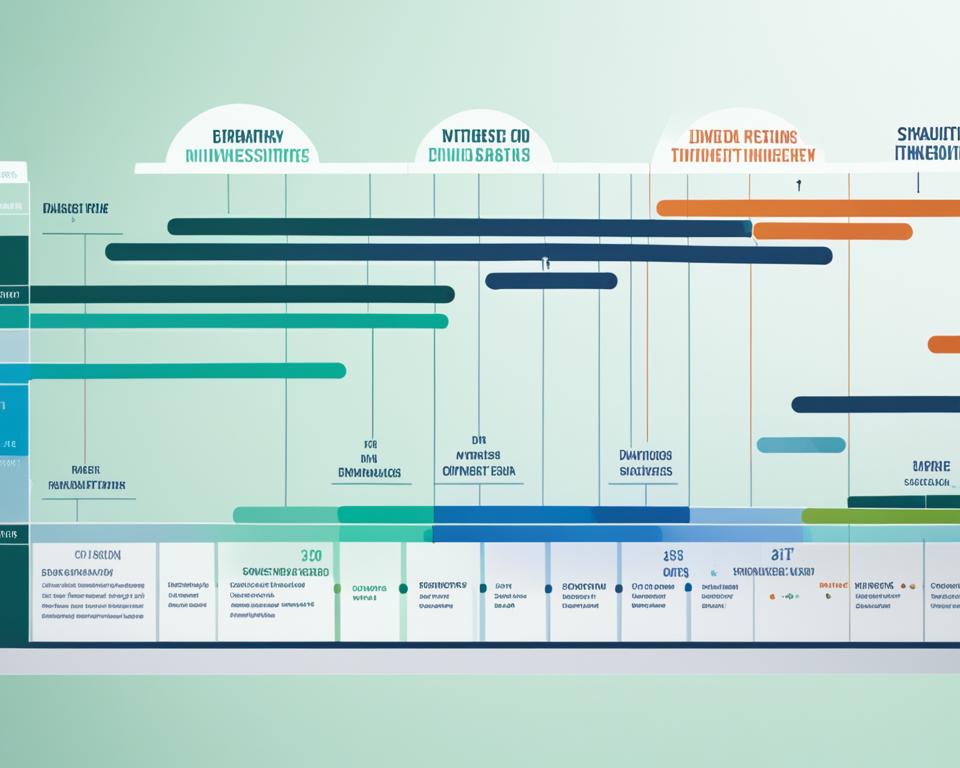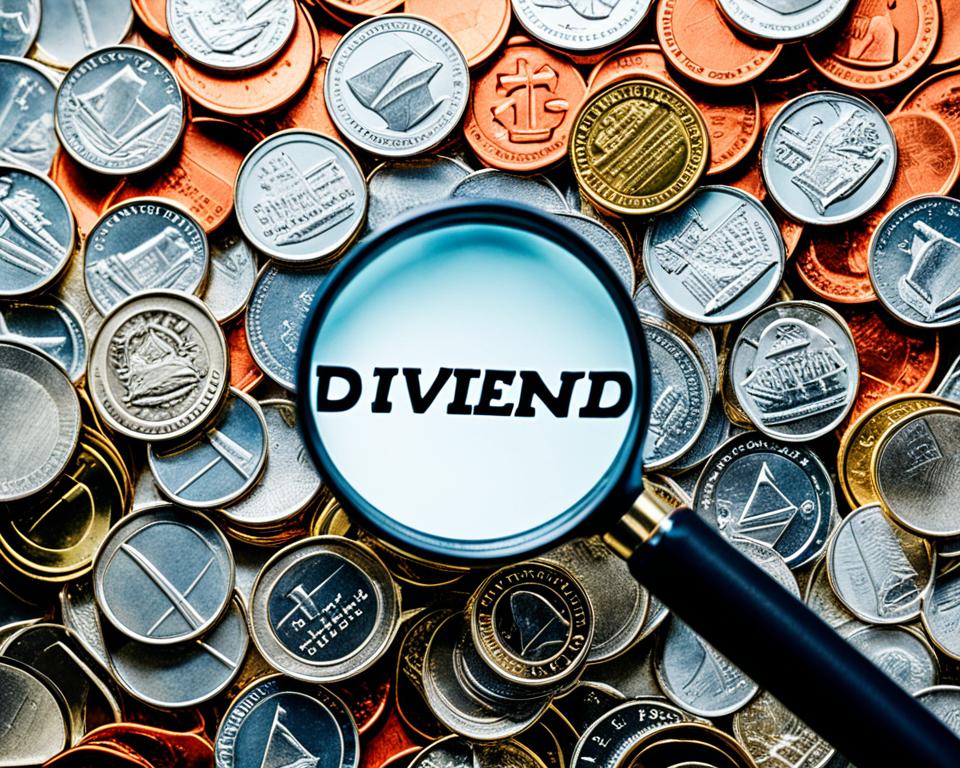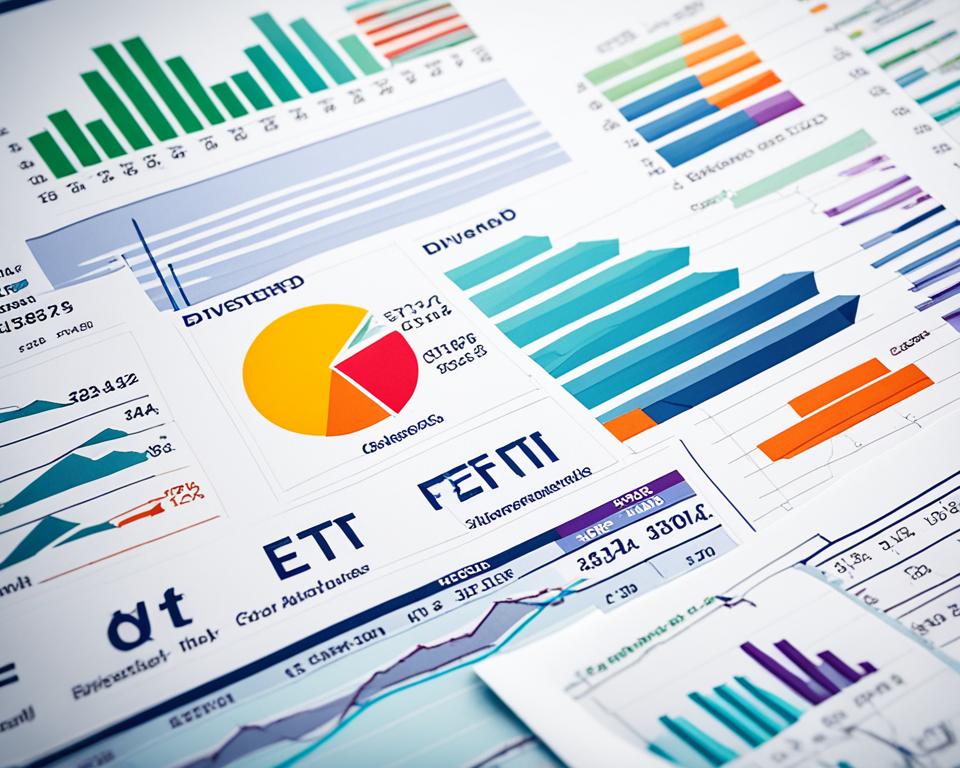As an investor, you’ve likely heard whispers and tales about the golden path of dividend investing. It’s often painted as a simple, risk-averse strategy that guarantees a steady stream of income alongside potential capital gains. Yet, the landscape is fraught with misconceptions about dividend investing that can trip up both novices and seasoned market players alike. Unlocking the truths about dividend investing requires a keen understanding that not all dividends are created equal and that the highest yields don’t always herald the healthiest returns.
Today, we’re here to pull back the curtain and reveal the intricacies behind these investments. Let’s clear the fog by debunking dividend investing myths, ensuring that your foray into this domain is based on fact, not fiction. Prepare to align your strategies with reality and potentially transform your portfolio into a powerhouse of well-considered picks.
Key Takeaways
- Dividend investing is not necessarily the straightforward, conservative strategy it’s often made out to be.
- The highest dividend yield doesn’t automatically imply the best investment choice; sustainability and growth potential matter.
- Sectors such as REITs and MLPs inherently have high payout ratios, which are structurally ingrained rather than indicative of risk.
- A savvy investor should be wary of ‘dividend traps’ that could lead to a cut in payouts, affecting stock value negatively.
- Gaining a true perspective on dividends requires a comprehensive look at a company’s financial health and strategic vision.
- Emerging dividend payers can offer exciting growth opportunities if the dividends are part of a sustainable corporate strategy.
Debunking Dividend Investing Myths
When you dip your toes into the waters of the stock market, you might feel the tempting pull of high dividend yields—promising both security and a lucrative return. But this is where many investors find themselves ensnared by one of the most pervasive dividend investing fallacies: the allure of high yields. Let’s unpack why these seeming beacons of profitability may not always signal the safe harbor they purport to offer.
Why High Dividend Yield Isn’t Always Advantageous
At first blush, a high dividend yield appears as an unmistakable sign of generosity from a company to its shareholders, doesn’t it? Yet, a sharp gaze beneath the surface often reveals a different narrative. A towering yield could imply a company’s hesitance to reinvest its earnings, preferring instead to distribute them among shareholders—a maneuver that may hint at scant opportunities for growth. This approach can hamstring a company’s expansion and, paradoxically, the sustainability of its dividends.
Moreover, pouring your capital into the stocks with the loftiest yields doesn’t just potentially tether you to stagnating enterprises; it also means you may overlook those dynamically evolving players who have yet to reach their crescendo in both dividend growth and capital appreciation. These under-the-radar investments could offer a more balanced total return, blending dividend income with significant potential for stock price appreciation.
The Trap of Using Dividend Yield as the Sole Performance Indicator
The fixation on yield as the singular lodestar of investment decision-making can lead you into a snare. Why? Because yield on its own is a deceptively simple metric. It tells you nothing of a company’s capacity to maintain, let alone grow, its dividend payouts over time. Here, the dividend payout ratio steps into the limelight, offering clarity. This indicator measures the portion of earnings disbursed as dividends, providing insight into a company’s discretionary space to invest in its own future.
A balanced approach to evaluating dividends will account for both the immediate yield and the payout ratio in tandem. It’s the interplay between these figures that can indicate a robust, thriving business capable of rewarding your trust (and investment) with consistent dividends that, importantly, have room to grow.
- Avoid being swayed solely by high yields without scrutinizing the underlying business fundamentals.
- Remember that a low dividend payout ratio may reflect a company’s ability to reinvest in growth—potentially leading to a higher total return in the long run.
- Strike a balance between the seduction of high yields and the conviction in a company’s capacity for reinvestment and growth.
Misunderstanding Dividend Safety and Reliability
When it comes to investing, dividends are often seen as a beacon of stability and reliability in a portfolio. Particularly with dividend aristocrats, which are known for their enduring history of increasing payouts, dividends have built an aura of invincibility. However, it’s prudent for you to delve deeper and recognize that not all dividends are cut from the same cloth. It’s essential to differentiate between sustainable dividends and those that could lead you into a financial quagmire.
Discerning the true nature of dividends requires a nuanced approach that considers a range of factors which go beyond the superficial allure of a high yield. The seductive high yield that a company presents could be a veneer masking underlying difficulties, warning investors of potential dividend traps. To help you navigate this complex terrain, let’s explore the signs that indicate a dividend’s sustainability and how you can sidestep the pitfalls of alluring yet treacherous dividends.
Recognizing the Signs of Unsustainable Dividends
Unsustainable dividends are not just disappointing but can be detrimental to your long-term investment goals. When a company’s payout exceeds its earnings or cash flow, it cannot be considered sustainable. A tell-tale sign of this conundrum is a high dividend payout ratio, which implies more money is leaving the company than is justifiable by its profits. Companies that persistently have high payout ratios may not have the necessary funds to invest in opportunities for growth, eventually affecting the dividend safety.
Closely monitor the company’s earnings reports. Consistent earnings dips or static growth figures can cast a long shadow on the sustainability of dividends. Furthermore, a sudden hike in dividends without concurrent business growth can be a red flag, suggesting that the payout may be a tactic to maintain investor interest rather than a reflection of financial health.
How to Spot Dividend Traps and Avoid Them
A dividend trap ensnares investors who are lured by the promise of high yields, only to find that the company is unable to sustain them. Start with a historical analysis; if a company has cut dividends in the past, especially during times of economic stability, it may not hold a strong commitment to maintaining them. Additionally, scrutinize the debt levels. If these are high and increasing, the company may find it challenging to balance debt repayment with shareholder rewards.
Another aspect you should consider is the dividend coverage ratio, which provides insight into whether a company is generating sufficient revenue to cover its dividend payments. A ratio of less than 1.5 could potentially indicate a company stretching its finances thin to cover dividends, making them potentially unreliable in the long term.
The safest route is to favor companies with a history of not just paying but also methodically growing their dividends, often known as dividend aristocrats. These companies have weathered economic downturns and still demonstrated a shareholder-friendly approach. By focusing on dividend safety and sustainability, rather than chasing the highest yields, you can better ensure that your investments provide reliable income over time.
Diverting Dividend Desires: Growth vs. Income
Amidst the ebbing and flowing tides of the market, you may have encountered the enduring myth that positions dividend stocks as the antithesis of growth investments. This flawed belief insinuates that these stocks are solely the domain of those who prioritize an income strategy over the pursuit of capital appreciation. In reality, this dichotomy between growth and income is not as clear-cut within the realm of dividend investing as some might assert.
The notion that seeks to box dividend stocks into a corner of market conservatism, reserved for the risk-averse and those satisfied with modest gains, is one of the most persistent dividend investing myths. Let’s traverse through this labyrinth of misconception and shed light on the dynamic aspects of dividend stocks that many fail to recognize.
Navigating the Misconception of Dividend Stocks as Low-Growth Investments
Contrary to popular belief, numerous dividend-paying enterprises are in their growth phase, actively reinvesting in their business to amplify their market footprint. Others stand on the precipice of burgeoning growth, poised to amplify their dividends in alignment with robust financial health and astute corporate strategies. In the face of market volatility, these companies may not only offer a desirable income through regular dividends but also exhibit potential for substantial capital gains.
To better understand the interplay between dividends and growth, consider the attraction of dividend aristocrats. These entities, renowned for enduring through cycles of market volatility with unwavering dividend growth, bear testimony to the possibility of achieving both stability and expansion.
Reflecting on the past performance during volatile markets reveals that some dividend-paying stocks may be insulated from extreme fluctuations, offering a steadying counterbalance in your portfolio. Discerning investors do not eschew growth; rather, they seek it in the less-obvious candidates—those dividend payers whose growth narrative is just beginning to unfold.
Here lies the crux of modern-dividend investing: A blend of income and growth, straddling the delicate balance between the immediate gratification of dividends and the long-term gratification of capital appreciation. By featuring these stocks in your investment strategy, you have the opportunity to defy outdated myths and embrace a more holistic approach to wealth accumulation.
Fostering an awareness of growth potential in dividend stocks can be a game-changer, especially in a portfolio crafted for resilience against market shocks. So, dispel those myths, and let’s chart a course toward an encompassing investment strategy—one that values growth and income in equal measure.
The Excitement of Dividend Stocks
Dividend stocks radiate a unique charm that captivates investors seeking both stability and growth. While the conventional wisdom may link dividend investing to the slow and steady approach typically found in utility stocks, the reality is that the dividend landscape is teeming with vibrant, dynamic companies. These entities aren’t just reliable; they’re innovating, expanding, and rewarding investors through strong dividend growth metrics.
Let’s dive deeper into understanding the reasons behind the excitement that high dividend growth companies offer, particularly as they shatter the myth of being mere income instruments and reveal their capacity for significant value appreciation.
The Potential for Dividend Growth in Dynamic Companies
Investors often seek the thrill of growth in the fast-moving currents of the stock market. Dynamic dividend companies offer such exhilaration by exhibiting robust financial health, coupled with the capacity and willingness to increase dividend payouts. These companies may come from various sectors—technology, healthcare, consumer goods—and yet they share one common feature: an upward trend in their dividend growth metrics. Rising dividends typically suggest a company’s confidence in its future cash flows, indicating sound business operations and strategic foresight.
Identifying Opportunities Beyond Utility Stocks
Exploring the world of dividends beyond the traditional realm of utility stocks opens up a landscape rich with opportunities. Even within sectors traditionally not known for high dividends, there are companies that have bucked the trend and emerged as attractive dividend payers with the potential for high dividend growth. Your portfolio can benefit from balancing the security of utility dividends with the growth-oriented dividends found in other sectors.

Below is a table showcasing companies from non-utility sectors that sport impressive dividend growth metrics, signaling their potential as lucrative investments for both income and growth.
| Company | Sector | 5-Year Dividend Growth Rate | Dividend Yield | Payout Ratio |
|---|---|---|---|---|
| Microsoft Corp. | Technology | 10% | 0.9% | 38% |
| Pfizer Inc. | Healthcare | 5.8% | 3.7% | 52% |
| Johnson & Johnson | Consumer Goods | 6.3% | 2.5% | 66% |
| Apple Inc. | Technology | 10.9% | 0.7% | 24% |
In addition to the traditional dividend payers, these examples represent the new breed of dynamic dividend companies that are not only providing current income but are also positioning themselves for growth, capable of enhancing shareholder wealth through both avenues.
To truly capture the exciting potential within dividend stocks, you should not only pursue high yields but also consider the comprehensive financial picture, the strategic management decisions, and the market position that could lead to increasing dividends over time. The emphasis should be on quality, sustainability, and growth prospect—factors that elevate dividend investing from the realm of “safe bets” to an engaging component of a diversified investment strategy.
Misconceptions about dividend investing?
When it comes to building a reliable income stream through the financial markets, dividend investing often emerges as a preferred investment strategy. Yet, many of you might be swayed by popular misconceptions about dividend investing that can lead to less than optimal decisions. It’s important to recognize that not all high-yielding assets are foolproof, nor are all dividends indicative of stability and consistent returns.
Contrary to a common narrative, sectors beyond utilities and telecoms can offer a stable dividend yield. Diversifying your income portfolio across various industries, including technology and healthcare, can mitigate the risks associated with any single market sector. Master Limited Partnerships (MLPs), for instance, are often more resilient to energy price volatility than many investors realize, as their business models typically involve steady, fee-based revenue streams.
Now, let’s address a prevailing myth: that high yields equate to superior investments. While an impressive dividend yield can be attractive, it’s crucial to delve into why the yield is high. A decline in stock price, for instance, can inflate the yield artificially, leading astute investors to look beyond face value to assess the long-term sustainability of dividend payouts.
A keen investor’s mantra should thus be: evaluate, not speculate. It means considering the company’s earnings, growth potential, and payout ratios, rather than jumping at a seemingly lucrative yield. Moreover, understanding the industry standards for payout ratios can prevent misunderstandings about what may constitute a risky investment.
- Question the high yields and seek the story behind the numbers.
- Expand your dividend portfolio beyond the traditional sectors—explore options in varying industries.
- Identify MLPs and other assets that offer stability sans the direct influence of market volatility.
- Make informed decisions based on comprehensive financial and market analyses.
Dividend investing, when approached with due diligence and a clear understanding of the market, can certainly provide a reliable income stream as part of a balanced investment strategy. Do not let misconceptions steer you away from the opportunities available across financial markets. By separating fact from fiction, you will open the door to wiser and potentially more profitable investment choices.
Parsing Dividend Payout Ratios
Dividend payout ratios serve as a compass for investors, pointing to the sustainability of a company’s dividend payments. For those of you integrating a dividend investing strategy, understanding these ratios is crucial. They are more than just figures—they encapsulate the capacity of a business to balance rewarding its shareholders and fueling its own growth.
Understanding Dividend Payout Ratio and Its Significance
At the core of dividend investing sits the dividend payout ratio—an indicator that measures what portion of corporate revenue is distributed to shareholders as dividends. This figure, typically expressed as a percentage, can tell you much about a company’s priorities and financial health. A sustainable payout ratio means a company is not only providing a return on your investment but is also maintaining enough cash flow to invest in its future—a balancing act that bodes well for long-term growth.
When a High Payout Ratio Can Signal Trouble
Yet, a high dividend payout ratio can be a red flag, suggesting that the company might be putting immediate returns over future cash flow and expansion. If a significant chunk of profits is consistently going to dividends, there’s less reinvestment in the business, possibly stunting future growth. However, it’s important to note that this doesn’t apply across the board; certain sectors, like REITs, traditionally have higher payout ratios due to their operational structure.
Let’s break down some numbers to give you a clearer picture. Behold a table illustrating various companies with their respective payout ratios.
| Company | Sector | Recent Dividend Payout Ratio | 5-Year Average Dividend Payout Ratio |
|---|---|---|---|
| Company A | Technology | 35% | 30% |
| Company B | Healthcare | 80% | 75% |
| Company C | Consumer Goods | 60% | 65% |
| Company D | Utilities | 75% | 70% |
As you can see, ratios vary across sectors, reflecting different business models and dividend strategies. To ensure you’re making informed decisions, look beyond the payout ratio; dig into trends in earnings growth, and examine debt levels to get a full financial picture. Only then can you gauge the true sustainability of a company’s dividends—a key to successful dividend investing.
Master Limited Partnerships and Dividend Assumptions
When you think of Master Limited Partnerships (MLPs), the energy sector and its associated volatility might spring to mind, potentially stoking concerns about the stability of dividends in your investment portfolio. However, the connection between MLPs and energy commodities extends beyond a mere bystander’s relationship to energy prices. Let’s delve into why MLPs represent more than just a direct bet on energy markets and how they can contribute to financial stability in a diversified portfolio.
Exploring MLPs Beyond Their Connection to Energy Prices
Typically, MLPs are structured to provide a steady flow of income, which often materializes in the form of higher yield dividends. This might raise eyebrows among those wary of the energy market’s ups and downs. But here’s a compelling fact: MLPs largely generate cash flow through transportation and storage services for energy commodities, activities that lead to reliable revenue streams. These fee-based business models allow MLPs to collect consistent “tolls,” regardless of the fluctuating prices of oil, natural gas, or other energy resources.
This robust financial framework enables MLPs to offer a measure of insulation against the volatility of spot market prices, thereby providing financial stability to your income-generating investments. Think of MLPs as the tollbooths on the energy highways—regardless of the cost of the cargo passing through, the toll for transportation and storage remains steady.
Moreover, the strategic focus on infrastructure and the long-term nature of their contracts typically lead to more predictable cash flows. This level of predictability is not only attractive from a stability standpoint but also from a dividend perspective, as it supports consistent and potentially growing payouts over time.
Let’s challenge a common misconception: MLPs are not inescapably tethered to the high seas of energy price swings. Instead, their resilience stems from their operational model, which anchors them against short-term market fluctuations. By understanding this crucial distinction, you can reconsider the role of MLPs within your portfolio, seeing them not as risky ventures at the mercy of energy prices, but as bastions of stability that can serve to uphold and even bolster your investment strategy. Here’s a breakdown of MLPs’ performance in recent years, highlighting their stability:
| MLP | Energy Service | 3-Year Average Dividend Yield | 3-Year Revenue Stability |
|---|---|---|---|
| MLP Gas & Pipeline Ltd. | Natural Gas Transportation | 6.5% | High |
| MLP Crude Transporters Co. | Oil Transportation | 7.2% | Medium |
| MLP Energy Storage Partners | Liquid Natural Gas Storage | 5.8% | High |
By drawing on these insights, the savvy investor can discern the intrinsic solidities of MLPs, seeing them as vehicles for sustainable income. Through leveraging the innate strengths of Master Limited Partnerships, which lie in their business model and less in the commodities they carry, your dividend strategy gains an extra layer of defense against market volatility, potentially leading to more tranquil financial waters.
Dispelling the Equivalence of Dividend and Value Investing
Embarking on the investing journey, you might equate dividend investing with value investing, perceiving both to spring from the same wellspring of investment wisdom. However, the waters of these strategies diverge, meandering through distinctive landscapes of financial goals and market perceptions. Recognizing these differences is key to navigating the stock market with finesse, ensuring that your strategy aligns with your objectives for capital gains and dividend income.

While both strategies encompass grounding principles of prudent stock valuation, their paths diverge when exacting on the objectives and outcomes they pursue. Let’s untangle these commonly conflated concepts to fortify your investing approach with clarity and targeted intent, maximizing your portfolio’s potential.
Differentiating Strategies of Dividend Investors and Value Investors
Value investors scout the markets for opportunities akin to hidden treasures – assets whose price languishes below their intrinsic value, poised for a rebound that promises lucrative capital gains. Their sphere of interest lies in undervalued stocks, ripe for purchase and holding until the market corrects and recognizes their true worth.
Conversely, dividend investors, while appreciative of value, follow the siren song of consistent and growing dividend income. Their eyes are set on the horizon of a company’s cash flow, payout stability, and the prospects of dividend hikes – a triad that sings of sustainability and reinforces the bulwark of their investment decisions.
The discerning investor understands that these strategies, while sometimes overlapping, cater to different temperaments and timelines. Where value investing might entail a patient wait for the market to adjust, dividend investing seeks the steady rhythm of returns, punctuated by the crescendo of potential growth in payouts.
In the bustling marketplace of stocks, these approaches unfurl their banners with distinct pledges – value investing with the thrill of discernment and eventual gain, and dividend investing with the promise of steady income and shareholder value. By delving into the nuances that set them apart, you can better align your portfolio with the symphony that resonates with your financial aspirations and risk temperament.
Dispelling Dividend Investing Fallacies
As you fine-tune your stock market strategy, it’s crucial to understand the inner workings and myths surrounding dividends, particularly when it comes to special dividends and how they affect stock prices. While high-yield opportunities such as special dividends might seem tantalizing at first glance, they come with nuances that could steer your investment strategy off course if not properly understood.
Why Big One-Time Dividends Aren’t Always Beneficial
Special dividends, also known as one-time dividends, often make headlines due to their substantial nature. But be wary of their glittering appeal. These payouts might seem like a windfall, yet there are implications that can alter your perception of their value. Following the announcement and subsequent payout of special dividends, the stock price often drops by a commensurate amount on the ex-dividend date. This immediate reduction reflects the value of the dividend paid out and cautions against the illusion of additional profit solely because of such dividends.
Understanding Dividend Adjustments on Stock Prices
Another aspect to grapple with is the timing of dividend adjustments on stock prices. To become a beneficiary of dividends, it’s imperative to hold the stock before the ex-dividend date, not simply by the record date as some mistakenly believe. The stock’s price will usually diminish by the amount of the dividend on the ex-dividend date, factoring in the anticipated distribution, which can surprise uninformed investors. Regular dividends, those given consistently by a company, are typically a more reliable indicator of long-term commitment to shareholders.
The table below underscores the impact of special dividends on stock prices by illustrating the adjustment in stock price post-dividend distribution:
| Company | Special Dividend Paid | Stock Price Before Ex-Dividend Date | Stock Price Adjustment on Ex-Dividend Date |
|---|---|---|---|
| Global Tech, Inc. | $5.00 per share | $150.00 | $145.00 |
| HealthCorp Pharma | $2.50 per share | $75.00 | $72.50 |
| Retail Giants Group | $1.00 per share | $50.00 | $49.00 |
By grounding your investment choices in a thorough understanding of these factors, including the significance of the ex-dividend date and the financial ripples of special dividends, you can knit a robust layer of insight over your corporate dividends approach.
Busting Myths Around Stock Dividends and Cash Dividends
When eying up opportunities to enhance shareholder value, you often encounter the crossroads of choosing between stock dividends and cash dividends. Each pathway carries its own set of features and tax implications, shaping how you perceive the rewards of your investments. As you seek clarity in this pivotal aspect of portfolio management, let’s debunk some common misconceptions and lay bare the essential distinctions.
Stock dividends, those intriguing payouts in the form of additional shares, seem to carry the magic of compounding your investment without an immediate tax event. The beauty here lies in deferral—no taxes are due until such a time when the shares are sold. The value lies in the potential for future growth, allowing you to amplify your stake in the company without currently dipping into your pocket for tax payments.
On the other hand, cash dividends present an immediate reward, placing real money into your account with a predictable regularity. However, this tangible benefit comes hand-in-hand with immediate tax implications. Cash dividends must be declared as income in the year they are received, often resulting in a tax bite that must be factored into your overall investment strategy.
Grasping these differences is paramount as it influences not just your immediate tax return but also your strategic approach towards building and maintaining shareholder value. To illustrate the real-world impact of these different dividend types, consider the following table displaying each’s potential effect on an investor’s portfolio and tax situation.
| Dividend Type | Tax Treatment | Impact on Shareholder |
|---|---|---|
| Stock Dividend | Not taxable until shares are sold | Increases the number of shares owned; defers tax liability |
| Cash Dividend | Taxable in the year received | Provides immediate income; incurs current tax cost |
Moreover, sources like Dividend University underscore that while stock dividends broaden your investment in a company, their ultimate worth hinges on the company’s continued success and stock performance. The shifting sands of the market call for a keen eye on both cash dividends and stock dividends to ensure that they align with your financial goals—be it immediate income or long-term growth.
An astute investor, you’re committed to constructing a resilient and prosperous portfolio. Clearing the mist around the types of dividends and their respective tax implications is a step toward safeguarding and elevating your shareholder value. Remember, informed decisions are the bedrock of successful investing.
The Mythical Quest for High Dividend Yields
In the financial odyssey towards wealth creation, high dividend yields often emerge as the sirens of the stock market, luring investors with their promise of steady income and capital preservation. But, as with any siren song, the pursuit of high yields can navigate your portfolio into treacherous waters if not pursued with caution and an understanding of dividend strategy risks.
How Chasing High Yields Can Lead to Risky Investments
The current financial landscape is replete with tales of yields towering above the market average. In such a low-interest-rate environment, these high dividend yields can be exceedingly alluring, seducing investors into taking unexpected detours in their investment journey. Yet, the fixation on yield alone can be misleading, masking the true financial health of a company.
The underlying dangers of high yields often reside in their origins—sometimes a consequence of a plummeting stock price rather than robust profitability. Such an inversely proportionate relationship between yield and price should raise alarms about sustainability. After all, the dividends that are not supported by solid earnings or cash flow may become unsustainable and risk reduction or elimination.
Investing predominantly in high-yield stocks, without a diligent analysis of a company’s ability to maintain or grow these dividends, is akin to building a castle on sand—precarious and vulnerable to the tides of market shifts.
Therefore, it’s imperative to delve beyond the initial appeal and scrutinize whether these dividends are signs of strong shareholder commitment or desperate measures to attract investors. More than just income, it’s your capital preservation at stake.
Let’s illustrate the scenario with a table that compares companies with significantly different yields and the associated risks:
| Company | Dividend Yield | Recent Stock Performance | Financial Health Indicators |
|---|---|---|---|
| Reliable Corp. | 4% | Stable Growth | Strong Earnings, Low Debt |
| Sirens Inc. | 9% | Declining Price | Weak Earnings, High Debt |
As observed in the table, Sirens Inc. may appear lucrative with a high dividend yield of 9%, but the declining stock price and weak financials signal potential pitfalls. Contrastingly, Reliable Corp. represents a more balanced approach, blending a respectable yield with indicators of sound financial health.
Ultimately, wise investors opt for a judicious examination of dividends within the broader context of overall company performance and financial health. Such an approach ensures that the pursuit of high dividends is not a flight of fancy but part of a strategic methodology to preserve capital while seeking sustainable returns.
Dividend Dates: More Than Just Timelines
When venturing into the realm of dividend investing, it’s easy to focus predominantly on picking the best-performing stocks or those with the most attractive yields. However, the savvy investor knows there’s a crucial element that often goes underappreciated: dividend dates. Understanding these dates, especially the ex-dividend dates, is pivotal to ensuring you meet the criteria for dividend payments and set your investing timelines accordingly.
Why Investors Must Understand the Importance of Ex-Dividend Dates
To optimize your dividend strategy, knowledge of ex-dividend dates is essential. This date is the cutoff point determining shareholder eligibility for the upcoming dividend. If you purchase a stock on or after the ex-dividend date, you will not receive the next dividend payout. Conversely, if you own the shares before this date, you are in the clear to receive the dividend. It’s a key date in the schedule that impacts not only your income stream but also the price of the stock you’re considering.
Common Confusions Around Dividend Dates and Payments
Many investors mistakenly believe that the dividend record date is the crucial date for determining their eligibility for a dividend payout. Yet, it’s the ex-dividend date that is the real game-changer—a subtle but significant distinction that contributes to a successful dividend investment strategy. Misunderstanding these dates can result in missing out on dividends, impacting your projected investing timelines and overall portfolio performance.
To dispel the confusion and provide a clearer picture, consider this example highlighting the importance of these pivotal dates:
| Company | Ex-Dividend Date | Dividend Record Date | Payment Date | Dividend Amount |
|---|---|---|---|---|
| Global Energy Co. | April 15, 2023 | April 17, 2023 | May 1, 2023 | $0.50 per share |
| Health Innovations Inc. | April 22, 2023 | April 24, 2023 | May 8, 2023 | $0.75 per share |
In this table, you can see the crucial ex-dividend dates are consistently before the dividend record dates. For shareholders who’ve had their eye on Global Energy Co. for its upcoming dividend, April 14th would be the last day to purchase shares to ensure eligibility for the May 1st payment.
Become a stratagem in your dividend investments by prioritizing the understanding of these dates. Each has its purpose and influence on your potential gains. Let the knowledge of ex-dividend dates, dividend record dates, and payment dates be your guide towards a more informed and beneficial investment pathway.

Tax Implications of Dividend Investing
As you venture into the world of dividend investing, a critical element that may not be immediately apparent is the taxation of the dividends you receive. Just as you carefully select your investments, approaching investment tax planning with the same rigor can prevent the unpleasant surprises of unexpected tax bills. To navigate the complexities of dividend taxation, it’s imperative to become acquainted with the distinct types of dividends and their respective tax considerations—knowledge that can make a significant difference in your after-tax returns.
How to Avoid Surprises by Understanding Dividend Taxation
Understanding dividend taxation is an essential component of successful investment tax planning, and it starts with distinguishing between qualified dividends and their non-qualified counterparts. Qualified dividends are typically taxed at the preferable capital gains rate, which tends to be lower compared to the rates applied to non-qualified dividends that are taxed as ordinary income. This difference in tax treatment can significantly influence your investment yields and should be carefully considered within your broader financial planning.
The beneficial tax treatment of qualified dividends, however, is subject to specific holding period requirements. You must own the stock for more than 60 days during the 121-day period that starts 60 days before the ex-dividend date. Not meeting this criterion means your dividends won’t qualify for the lower tax rate—a detail that certainly warrants attention.
Different income tax rates that apply across various income brackets further complicate the picture. What compounds these challenges is the unique tax treatment extended to specific investment vehicles, such as Real Estate Investment Trusts (REITs) and Master Limited Partnerships (MLPs). These dividends are typically taxed at the ordinary income tax rates, but this general rule is subject to change based on evolving tax laws and individual circumstances.
| Investment Type | Qualified Dividend Eligible | Typical Tax Rate |
|---|---|---|
| Individual Stocks | Yes, if holding period met | 0%, 15%, or 20% |
| REITs | No | Ordinary Income Rates |
| MLPs | Varies | Ordinary Income Rates or Capital Gains Rates |
To ensure your investment tax planning is on track, it’s prudent to consult with a tax professional who can guide you through these intricate details and help align your dividend investments with your financial objectives. By doing so, you can not only optimize your returns but also guard against any unforeseen tax liabilities that could encroach upon your investment earnings.
Remember, diligent planning and understanding of dividend taxation, including the nuances of qualified dividends and the income tax rates applicable to your specific situation, are cornerstones to maximizing your investment’s potential. So, arm yourself with knowledge, plan strategically, and invest with an eye towards tax efficiency to truly capitalize on the benefits of dividend investing.
Choosing Between Dividend Funds and Individual Stocks
As you consider strengthening your portfolio with passive income streams, a fundamental decision you’ll face is choosing between dividend funds and individual dividend stocks. Each option has its unique set of benefits and trade-offs that can influence your financial journey. Whether you prioritize diversification, control, or direct ownership will shape your approach to investing in high-yielding assets like mutual funds and ETF investments. Let’s examine the pros and cons to help steer your investment strategy in the right direction.
The Pros and Cons of Investing in Dividend ETFs vs. Individual Dividend Stocks
Dividend funds, which include both mutual funds and ETFs, offer a level of diversification that is difficult to achieve when purchasing individual stocks. This diversification can protect against the volatility of the market, spreading risk across a wide range of assets. Yet, this comes at the cost of fund management fees, which can eat into your returns over time. Additionally, investors may find themselves with less control over the exact composition of their investment portfolio.
On the other hand, selecting individual dividend stocks puts you in the driver’s seat, providing the opportunity to tailor your portfolio to your specific risk tolerance and financial goals. This direct approach permits a deeper dive into company metrics, empowering you to make decisions based on thorough due diligence. However, it requires a substantial investment of time and expertise in analyzing company performance and understanding market dynamics.
To provide a clearer view, here’s a comparative table that summarily presents key attributes of choosing either dividend funds or individual stocks:
| Investment Type | Diversification | Management Fees | Control Over Selection | Time Commitment |
|---|---|---|---|---|
| Dividend Funds (ETFs/Mutual Funds) | High | Varies (Usually Present) | Low | Low |
| Individual Dividend Stocks | Varies (Based on Number of Stocks) | None | High | High |
Ultimately, your decision may hinge on your investment acumen and how actively you wish to participate in the management of your investments. Both dividend funds and individual stocks can play a vital role in creating a robust income-generating portfolio, but aligning your choice with your personal investment philosophy is key to long-term satisfaction and success in the realm of dividend investing.
Truths About Dividend Investing
When venturing into the world of investments, the allure of dividend stocks stability often guides investors towards the perceived safety of established dividend-paying companies. And while it’s true that these investments can be a beacon of steadiness amidst market turbulence, the evolving landscape of emerging dividend stocks warrants a more nuanced approach to ensure the protection of your shareholder equity.
Realizing the Potential Stability in Dividend Stocks
In the quest for reliable income, dividends from time-honored corporations have served as a stalwart of stability—an appealing trait for those looking to safeguard their investments. It’s this very characteristic of dividend stocks stability that has endorsed them as an integral component of a well-rounded portfolio. The historical performance of such entities often illustrates a track record of consistent payouts, bolstering faith in their enduring nature.
Earnings growth and cash flow, two critical financial health indicators, are steady in these corporate stalwarts, reinforcing investor confidence in the sustainability of dividend payments. But it’s imperative to acknowledge that stability doesn’t imply immobility—many such companies continue to innovate and grow, further cementing their role as reliable dividend providers.
Approaching Emerging Dividend Payers with Caution
On the other side of the spectrum are the emerging dividend stocks, entwined with the potential for growth but peppered with uncertain outcomes should their dividend promises surpass financial reality. These fledgling entrants in the dividend domain bring excitement and diversification opportunities, yet they should be approached with discernment and a commitment to analyzing their long-term viability.
Assessing whether an up-and-coming company’s dividend is a precursor to stability or a fleeting show of generosity is pivotal. Take, for instance, a tech startup that has recently initiated a dividend policy. While the decision might hint at stability, a deep dive into their fiscal strength is essential to confirm if they can maintain their pledge to shareholders without compromising future growth.
Delving into the full breadth of financial indicators, including earnings growth, debt-to-equity ratio, and cash flow metrics, assists in painting a clearer picture of these nascent dividend issuers. Investors intent on supplementing their portfolios with these potential gems must be vigilant, seeking assurance that dividend distributions are backed by solid and sustainable earnings.
To elucidate the balance between established and emerging dividend stocks, consider this table:
| Criteria | Established Dividend Payer | Emerging Dividend Payer |
|---|---|---|
| Track Record | Long history of consistent dividend payments | New or inconsistent dividend history |
| Financial Health | Strong earnings and cash flow | May have variable earnings and cash flow |
| Growth Potential | Steady but slower growth | Higher growth potential but with greater risk |
| Investor Consideration | Sought for reliability and stability | Attractive for potential, but requires thorough analysis |
As you span the dividend spectrum, it becomes evident that the true art of dividend investing lies not just in seeking the haven of longstanding payers but also in carefully selecting and nurturing your stake in emerging entities. By exercising prudence and informed scrutiny, you can strategically balance stability with growth, thereby fostering a portfolio that embodies adaptability and foresight.
Conclusion
In the journey through the dividends maze, you’ve equipped yourself with the tools to demystify common misconceptions and hone smarter dividend investment strategies. It’s about stepping into the arena with enhanced financial literacy, ready to analyze and act with precision. This new vantage point will not only help you identify genuine growth opportunities but also secure a more substantial and stable income flow from your investments.
Integrating Knowledge to Forge Smarter Dividend Investment Strategies
Investment expertise isn’t static—it thrives on your willingness to learn and adapt. By challenging the entrenched myths about dividend stocks, you’re better positioned to sift the wheat from the chaff. Remember, a high dividend yield may sometimes be a siren call towards precarious financial shores. Your investing acumen, now sharpened with a deeper understanding of dividend intricacies, empowers you to make discerning choices that align with smart, growth-oriented strategies.
Summarizing Key Points to Debunk Common Dividend Investing Misconceptions
Gleaning insights from this comprehensive dissection of dividend investing, the key to success rests on recognizing the multi-faceted nature of dividends—and by extension, your investment portfolio. Not all high-yield dividends are cast in gold, nor are all stable appearing stocks free from risk. Your diligent approach to evaluating dividend stocks, understanding their tax implications, and integrating these insights into a cohesive investment strategy paves the way for enhanced shareholder returns and solidifies your footing in the terrain of financial markets. As you apply these truths, you fortify your ability to debunk common misconceptions and foster a strategically robust portfolio crafted to weather the ever-evolving market dynamics.
FAQ
What are some common misconceptions about dividend investing?
There are several misconceptions, including the belief that a high dividend yield is always advantageous, that dividend stocks are inherently safe and do not offer growth opportunities, and that all dividend stocks provide a reliable income stream. These beliefs oversimplify the varied and complex nature of dividend investing.
Why is a high dividend yield not always advantageous?
A high dividend yield may indicate underlying company issues such as a reluctance to reinvest profits or a lack of growth opportunities. It can also be a sign that the stock price has fallen significantly, potentially signaling a red flag for investors.
What does it mean if a company has a high dividend payout ratio?
A high dividend payout ratio may suggest that a company is distributing a large portion of its earnings to shareholders. While this can be favorable for producing an income stream, it may suggest limited opportunity for reinvestment and growth or even risk to the dividend’s sustainability if earnings drop.
What are the signs of an unsustainable dividend?
Signs of an unsustainable dividend include a high payout ratio that exceeds earnings, stagnant or declining earnings, poor cash flow, and a large amount of debt. These factors may indicate that a dividend cut or suspension could be forthcoming.
Are dividend stocks always low-growth investments?
No, this is a misconception. Many dividend-paying companies are in fact in growth phases or have the potential for future growth, resulting in both capital appreciation and dividend income for investors.
How can investors identify high growth potential in dividend stocks?
Investors can look for companies with strong dividend growth metrics, healthy earnings, and cash flow, as well as strategic corporate initiatives that may lead to future growth and higher dividends.
What should investors understand about Master Limited Partnerships (MLPs) and their dividends?
Investors should understand that MLPs often have stable cash flows due to fee-based revenues, making them less susceptible to short-term energy price fluctuations. This can provide a consistent dividend income stream, regardless of volatile energy market prices.
What is the difference between dividend investing and value investing?
Dividend investing focuses on generating a steady and potentially growing income stream through dividends, while value investing is about buying stocks believed to be undervalued by the market and profiting from the eventual correction of their stock prices.
Why aren’t big one-time dividends always beneficial to investors?
While special dividends can be a bonus for investors, they often result in an equivalent reduction in the stock price on the ex-dividend date. Moreover, they do not reflect a long-term commitment to continuous dividend payments.
What is the difference between stock dividends and cash dividends, and why does it matter?
Stock dividends are paid in the form of additional shares and are not immediately taxable, while cash dividends are paid in cash and are taxable in the year they are received. The difference is crucial for tax planning and assessing the true value to an investor’s portfolio.
How can chasing high dividend yields be risky?
High yields may be indicative of problems such as a falling stock price or an unsustainable dividend. Investing based solely on high yields without comprehensive analysis can expose investors to potential capital losses.
Why is it important to understand ex-dividend dates?
Understanding ex-dividend dates is critical as they determine when you must own the stock to be eligible for the next dividend payment. Confusion surrounding these dates can result in missed dividends or misinformed trading decisions.
How are dividends taxed, and why is this important?
Dividends are taxed differently based on whether they are qualified or non-qualified. Qualified dividends are taxed at a lower capital gains rate, while non-qualified dividends are taxed at ordinary income rates. Knowing the difference can influence an investor’s tax liability and investment decisions.
Should investors choose dividend funds or individual dividend stocks?
The choice between dividend funds and individual stocks depends on an investor’s experience, risk tolerance, and investment preferences. Funds offer diversification but might include management fees, while individual stocks offer more control but require a greater due diligence.
How should investors approach emerging dividend-paying companies?
Investors should approach emerging dividend payers with a focus on the sustainability of dividends, considering factors like earnings growth, cash flow, and the overall stability of the company’s financial health.
How can investors forge smarter dividend investment strategies?
By understanding the intricacies of dividend investing, including distinguishing between high-yield traps and sustainable dividends, recognizing the growth potential in dividend stocks, and being aware of tax implications. This knowledge facilitates the creation of a more sophisticated and sustainable investment approach.












